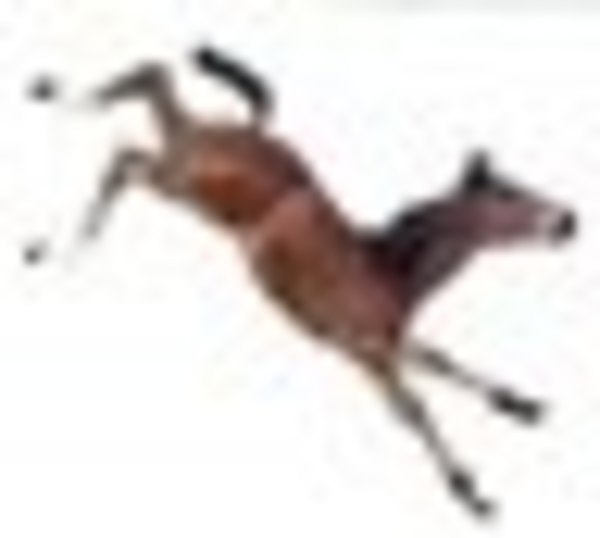Reader reactions to last week’s blog article on weight issues in pleasure horses startled me. I expected a ho-hum, what-else-is-new reaction, and was thrilled that so many people were supportive, sent emails, linked to the article, Twittered about it or left comments. Thanks!
It is obviously a subject we all feel strongly about. For many of us, it’s about guilt.
I’ve written extensively about the frustrations of trying to keep a horse on a feed restriction program when the horse is kept in a boarding barn where the owner doesn’t control the feeding, the feed or the schedule. Been there, done that. Queue the tears.
One of the first things I did was give up on weight tapes. A camera seemed to be a better gauge of the mare’s weight than anything. Side-by-side images showed where she tended to put on weight and when she lost weight, where she flattened out first. It was amazing to watch.
The good people at World Horse Welfare have been funding research on monitoring weight gain and weight loss and today we have some results to report.
Two recent weight loss studies have both shown that belly girth measurements, defined as taken at the widest point of the belly, approximately two-thirds of the way between the point of the shoulder and the point of the hip, are more closely related to changes in body weight in early weight loss (after the first week of feed restriction) as opposed to the more commonly used heart girth measurements or even some ultrasound fat measurements.
A study titled Managed Weight Loss in Obese Ponies: Evaluating Weight Change, Health and Welfare, conducted last year by researchers at the Department of Veterinary Clinical Science at the University of Liverpool in England and supported by World Horse Welfare, suggested that it would be beneficial to find a more accurate method for monitoring early weight loss in overweight ponies rather than relying on conventional equine body condition scoring.
This research was touched upon in the World Horse Welfare video in last week’s post on obesity awareness.
A further study comparing two practical weight-loss protocols for the management of overweight and obese horses and ponies was conducted earlier this year by the same group and funded by the British government-initiated Knowledge Transfer Partnership and the WALTHAM Equine Studies Group. It confirmed that the proportional change in belly girth was more closely associated with changes in body weight than the proportional change in heart girth in the early stages of weight loss.
Dr Caroline Argo and Alex Dugdale at the University of Liverpool said: “It is important for owners to understand that early weight loss is not immediately recognizable as a change in the horse or pony’s overall appearance or body condition score.
“However, owners do need some assurance that measures taken to promote weight loss are being effective. Simply measuring belly girth at regular (weekly) intervals can provide this. Without such reassurance, we might be inclined to either give up or, more alarmingly, harmfully increase our efforts to induce weight loss.”
Clare Barfoot BSc (Hons) RNutr, the research and development manager for the British horse feed company SPILLERS? was a member of the research team for the second study. She commented: “Our findings clearly support the concerns raised in the initial study on the accuracy of using conventional body condition scoring or heart girth measurements to monitor early weight loss.
“Although weigh tapes used around the heart girth can estimate body weight, they are not as reliable in picking up early weight changes in weight loss programs. Measurements around the belly girth have proved to be a more reliable way to monitor weight loss although it is important to ensure that the initial measurement is taken a week after food restriction to accommodate initial losses in gut fill and water, and that measurements are taken in a standard way at a similar time of day.”
Samantha Lewis, “Right Weight” Program Manager for World Horse Welfare, added: “This research will be of great benefit to owners who are taking steps to help their horses lose weight by enabling them pick up on changes at an earlier stage. While weigh tapes used at the heart girth can be useful to obtain estimates of body weight, changes in belly girth may be more sensitive for monitoring early changes in weight when obese ponies are encouraged to lose weight.”
Of course, there’s one true-blue, never-fail system that always works for me and I know it will work for you too. Maybe I can get a research grant to write it up. Throw a saddle on the horse and prepare to go for a ride. Notice what hole in the girth you use. Ride. Work up a little bit of a sweat. Cool down. Repeat daily for a month or so. After even the first few days, you should notice that you’re using a different hole in the girth, even though that’s not the newly-holy belly girth. After a month or two, you might need to buy a new girth. Or a new saddle, because your horse will have a whole new shape.
Maybe I could market a weight-loss girth with colored bands around each hole so that riders really would notice what hole they are using and when they are expanding the girth (in the spring, for instance) and when they are tightening it as the horse loses weight. World Horse Welfare, are you listening?
I realize that some horses are ridden regularly and still have weight problems but some overweight horses would just love to get out of the pen and get some exercise!
by Fran Jurga | The Jurga Report at Equisearch.comBe friends withFran Jurga on Facebook.comDon’t miss Discover WEG with Fran Jurga for fun at the Games!









